- A list of UNESCO world heritage sites in India
with pictures.
India, often referred to as a living museum, showcases an astounding array of historical architectures that bear witness to the nation’s rich and diverse past. These architectural marvels, recognized by UNESCO, not only stand as symbols of India’s history but also offer insights into the cultural, artistic, and architectural achievements of the subcontinent.
Let us embark on a journey through the top 10 Indian states that proudly house these UNESCO recognized historical treasures. Monument picture is before description. Links to 40 albums given at end of article. Sites on UNESCO Tentative List included.
1 Karnataka
The state of Karnataka in India is a treasure trove of architectural brilliance, with several UNESCO recognized sites that capture the essence of its history and culture. Among these, the “Sacred Ensembles of Hoysala” and the “Badami Chalukya Architecture” stand as prominent examples of Karnataka’s architectural heritage.
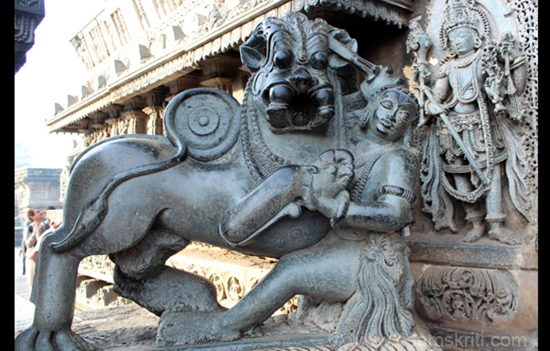 Royal Emblem of the Hoysala dynasty.
Royal Emblem of the Hoysala dynasty.
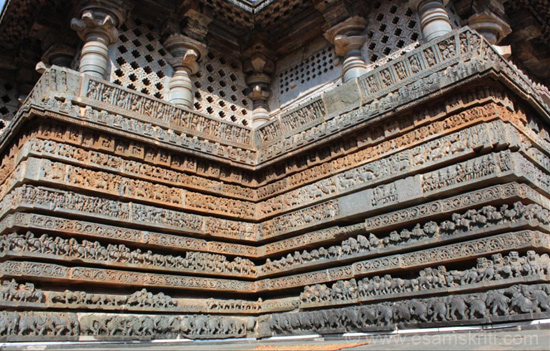 Halebidu Temple.
Halebidu Temple.
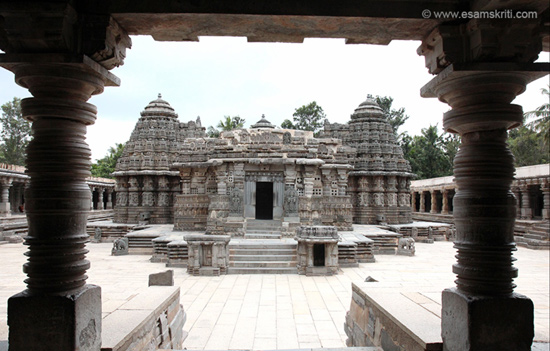 Hoysala Temple, Somnathpura near Mysore.
Hoysala Temple, Somnathpura near Mysore.
The Sacred
Ensembles of Hoysala architecture, characterized by intricate carvings and exquisite craftsmanship, includes temples like the Chennakeshava Temple in Belur and the Hoysaleswara Temple in Halebidu. These temples are a testimony to the Hoysala dynasty’s artistic prowess, showcasing a blend of Dravidian, Nagara, and Vesara architectural styles.
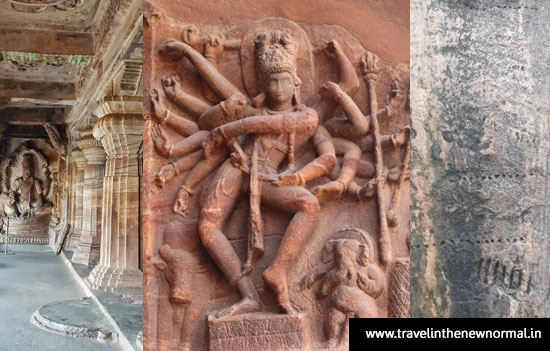 Badami Caves. 18 hands Nataraja dancing on a lotus.
Badami Caves. 18 hands Nataraja dancing on a lotus.
The Badami
Chalukya Architecture encompasses the rock-cut temples of Badami, Aihole, (not declared as yet) and Pattadakal. These sites offer a glimpse into the Chalukya dynasty’s architectural innovation. Aihole, often referred to as the “Cradle of Indian Architecture,” boasts diverse temple structures, including the revered Durga Temple and the intricately adorned Lad Khan Temple, that showcase the experimental spirit of its builders.
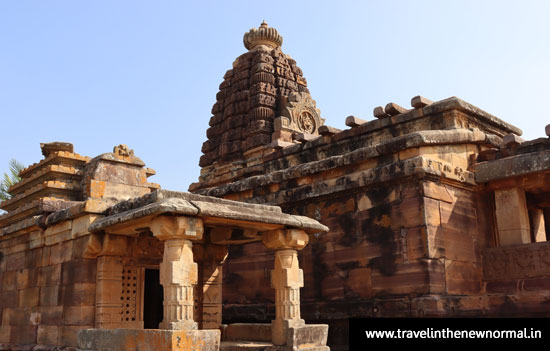 Pattadakhal Temples.
Pattadakhal Temples.
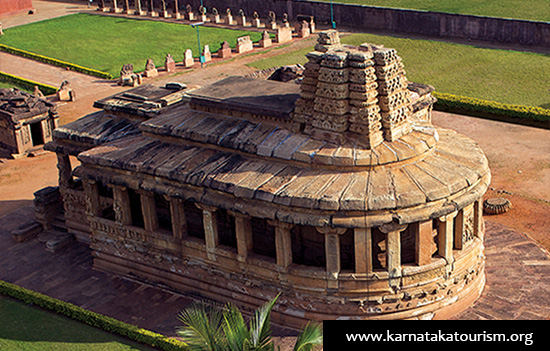 Durg Temple, Aihole.
Durg Temple, Aihole.
Pattadakal, a UNESCO site, boasts
masterpieces like the Virupaksha Temple, Mallikarjuna Temple, and the
intricately detailed Papanatha Temple, representing the culmination of northern
and southern architectural influences. The Badami Cave Temples, hewn out of
sandstone cliffs, are a testament to the ingenuity of the Chalukya architects.
These cave temples, with intricate sculptures and architectural detailing,
narrate tales of devotion and artistic mastery.
In addition to these ensembles, Srirangapatna and Hampi further enrich Karnataka’s architectural legacy. Srirangapatna is home to the grand Ranganathaswamy Temple, a blend of Dravidian and Vijayanagara architectural styles.
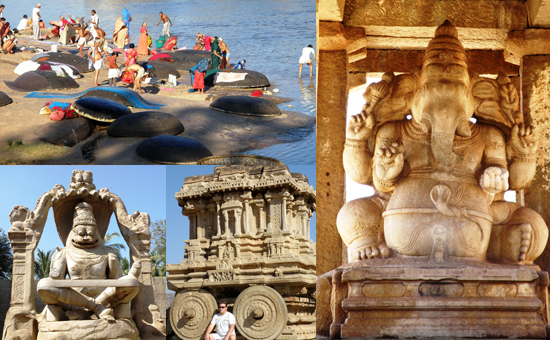 Hampi collage.
Hampi collage.
Hampi, a UNESCO World Heritage Site,
transports visitors to the ruins of the Vijayanagara Empire, where the
Virupaksha Temple and the Vittala Temple complex stand as exquisite examples of
architectural excellence.
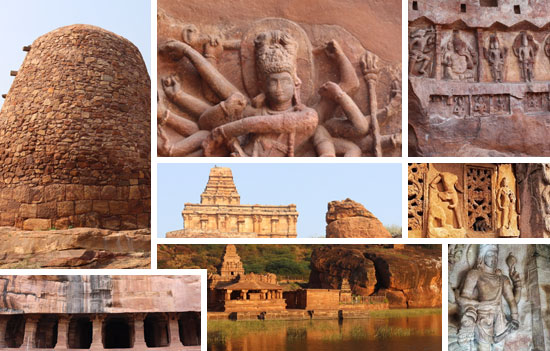 Chalukyan architecture.
Chalukyan architecture.
The Sacred Ensembles of Hoysala, Badami Chalukya Architecture, and the architectural wonders of Srirangapatna (not declared as yet) and Hampi collectively narrate Karnataka’s story through stone and sculpture, offering a deep insight into the state’s cultural evolution and architectural brilliance.
2 Tamil Nadu
The state of Tamil Nadu in India boasts a rich tapestry of historical and architectural treasures that have been recognized by UNESCO for their outstanding cultural significance. Among these treasures, the Group of Monuments at Mahabalipuram, the Ranganathaswamy Temple in Srirangam, the Temples of Kanchipuram, and the Great Living Chola Temples stand as iconic examples of Tamil Nadu’s architectural prowess and spiritual depth.
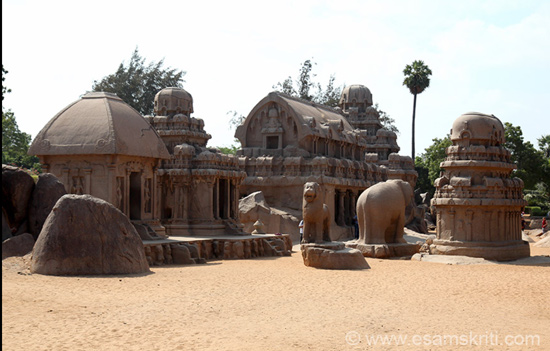
The Group of
Monuments at Mahabalipuram, also known as Mamallapuram, showcases a collection
of intricately carved rock-cut temples and sculptures that depict episodes from
Hindu mythology and everyday life. The iconic Shore Temple, with its proximity
to the Bay of Bengal, is a breathtaking sight that beautifully marries
architecture and nature.
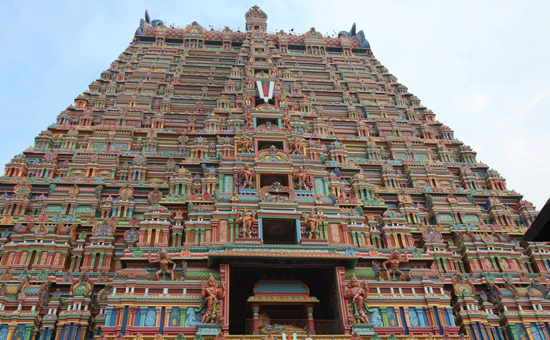
The Ranganathaswamy
Temple in Srirangam (not declared as yet) is a monumental edifice dedicated to Lord Vishnu. Its seven enclosures, colossal gopurams (towers), and intricate carvings make it one of the largest functioning Hindu temples in the world.
The Temples of
Kanchipuram (site on UNESCO Tentative List) represent a treasure trove of architectural diversity. From the towering Ekambareswarar Temple dedicated to Lord Shiva to the Kailasanathar Temple’s intricate sandstone carvings, Kanchipuram’s temples offer a journey through centuries of architectural evolution.
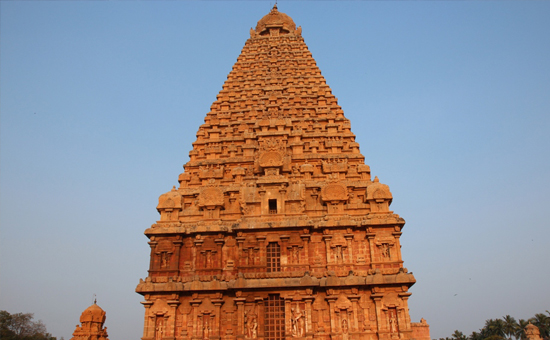 Brihadesvara Temple.
Brihadesvara Temple.
The Great Living Chola Temples, a UNESCO World Heritage Site, consist of the Brihadeeswarar Temple in Thanjavur, the Gangaikonda Cholapuram Temple, and the Airavatesvara Temple in Darasuram. These temples, built during the Chola dynasty, showcase the grandeur of Dravidian architecture and stand as a tribute to the region’s artistic and cultural achievements.
Tamil Nadu’s UNESCO recognized sites are a testament to the state’s profound spiritual heritage, artistic brilliance, and architectural diversity. These monuments transcend time, inviting visitors to immerse themselves in the intricate narratives of history, culture, and devotion.
3 Madhya Pradesh
The state of Madhya Pradesh in India holds
within its boundaries a treasure trove of historical and architectural gems,
several of which have been recognized by UNESCO for their cultural
significance. From the Great Stupa at Sanchi to the Khajuraho Group of
Monuments, these sites offer a glimpse into the rich history and architectural
splendor of the region.
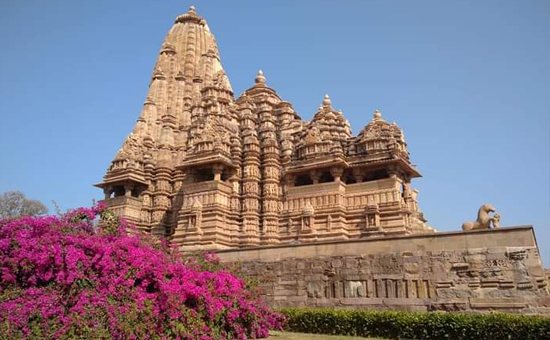 Kandariya
Mahadev Mandir, Khajuraho.
Kandariya
Mahadev Mandir, Khajuraho.
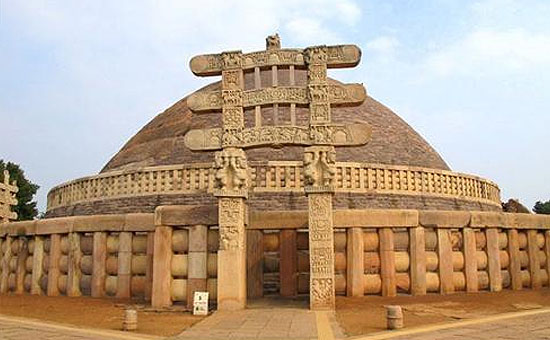
The Great Stupa at
Sanchi is
an ancient Buddhist monument that exudes serenity and spiritual depth. Its
intricately carved toranas (gateways) depict scenes from the life of Buddha,
offering a window into the teachings and traditions of Buddhism.
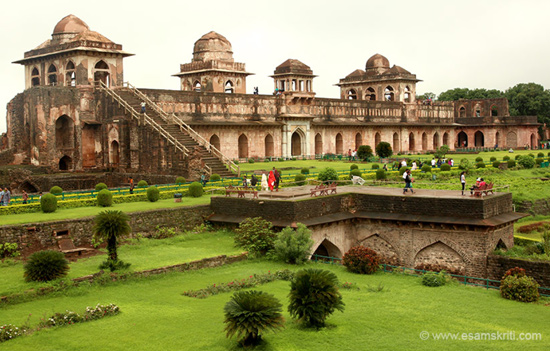
Not on UNESCO list but architectural wonders. Mandavgad, also known as Mandu, is a hill fortress
that narrates tales of romance and grandeur. The Jahaz Mahal and the Hindola
Mahal, with their exquisite architecture, stand as a testament to the artistic
achievements of the Malwa Sultanate.
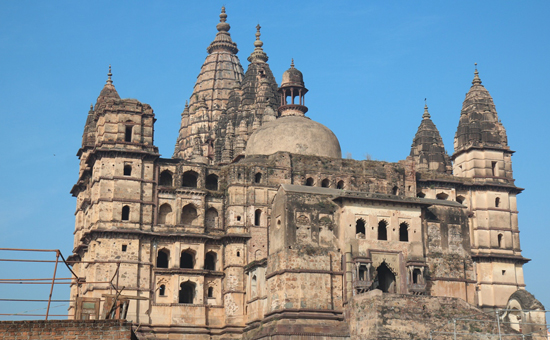 Chhaturbhuj
Temple, Orchha.
Chhaturbhuj
Temple, Orchha.
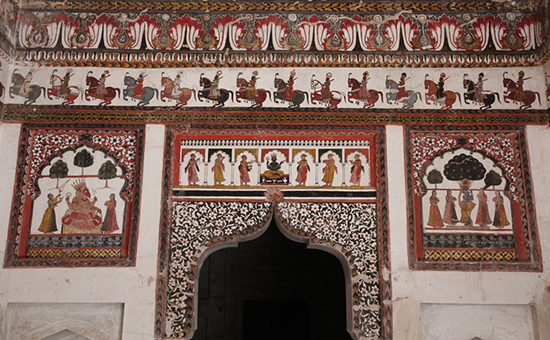 Paintings inside Raja
Mahal, Orchha.
Paintings inside Raja
Mahal, Orchha.
The Historic
Ensemble of Orchha transports
visitors to a bygone era. The Orchha Fort, Jahangir Mahal, and Raj Mahal tell
stories of medieval splendor and architectural innovation.
The Udaygiri Caves near Vidisha unveil a series of rock-cut sanctuaries adorned with intricately carved sculptures and inscriptions. These caves provide insights into the region’s cultural and artistic heritage.
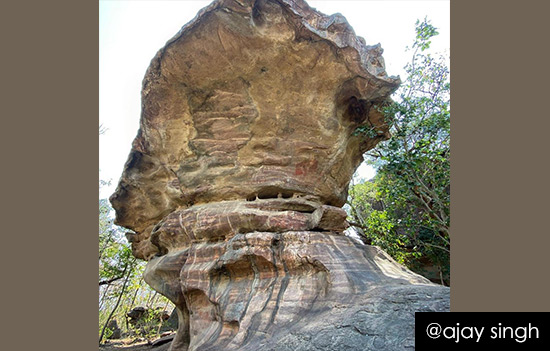
Bhimbetka Rock
Shelters,
recognized as a UNESCO site, are a window into prehistoric art. These shelters,
adorned with ancient paintings, reveal the creativity and cultural practices of
early human societies.
Madhya Pradesh’s UNESCO recognized sites span various epochs and artistic styles, reflecting the state’s historical depth and cultural diversity. Each monument and cave is a chapter in the narrative of India’s past, inviting us to explore and appreciate the layers of history etched into the state’s architectural heritage.
4 Bihar
Bihar, a state rich in spiritual and
intellectual heritage, houses two UNESCO recognized sites that are of profound
cultural and historical importance: the Mahabodhi Templ and the Nalanda
Mahavihara.
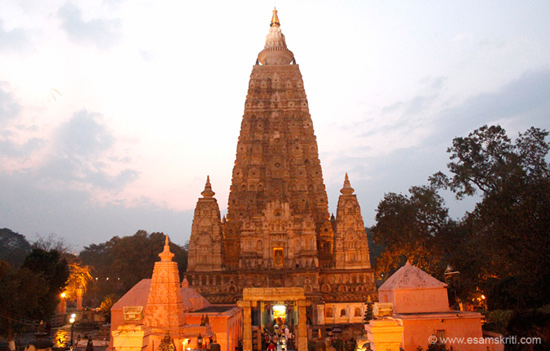
The Mahabodhi
Temple in Bodh Gaya is a sacred pilgrimage site for Buddhists worldwide. It marks the location where Siddhartha Gautama attained enlightenment under the Bodhi tree. The temple’s architecture is a blend of various styles, reflecting the contributions of different dynasties over the centuries. The intricately carved railings, the towering main temple, and the serene Bodhi tree together create an atmosphere of tranquility and devotion.
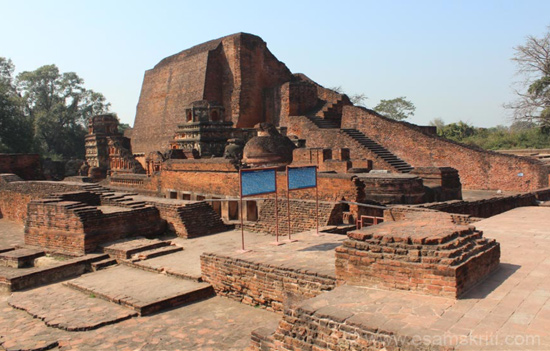
The Nalanda
Mahavihara, located near the town of Nalanda, was a center of learning in ancient India. It was a renowned seat of Buddhist education, attracting scholars and students from across the world. The complex comprises temples, monasteries, and libraries, attesting to the intellectual legacy of ancient India. The ruins stand as a testament to Nalanda’s significance as a hub of knowledge and philosophical exploration.
These UNESCO sites in Bihar reflect the state’s deep connection to spiritual awakening and intellectual exploration. The Mahabodhi Temple honors the birthplace of Buddhism, while the Nalanda Mahavihara underscores Bihar’s historical role as an epicenter of education and philosophy. Both sites stand as a bridge between the past and the present, inviting visitors to contemplate the enduring wisdom and cultural heritage they embody.
5 Maharashtra
The state of Maharashtra, nestled on India’s western coast, proudly hosts three UNESCO recognized treasures: the Ajanta, Ellora, and Elephanta Caves. These cave complexes are a testament to the artistic ingenuity, spiritual depth, and cultural richness that have defined India’s history.
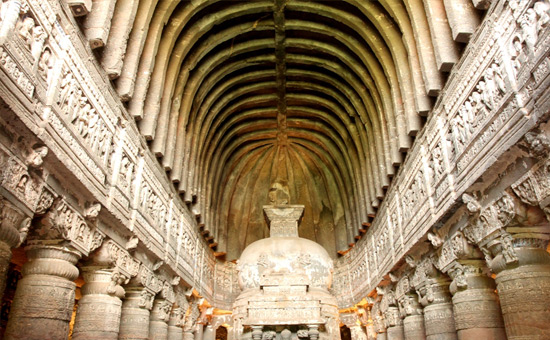 Cave 14 Ajanta Caves.
Cave 14 Ajanta Caves.
The Ajanta Caves, located amidst lush
surroundings, unveil a series of rock-cut Buddhist monastic complexes adorned
with intricate murals and sculptures. These ancient artworks offer insights
into the social, cultural, and religious dynamics of their time, showcasing the
evolution of artistry over several centuries.
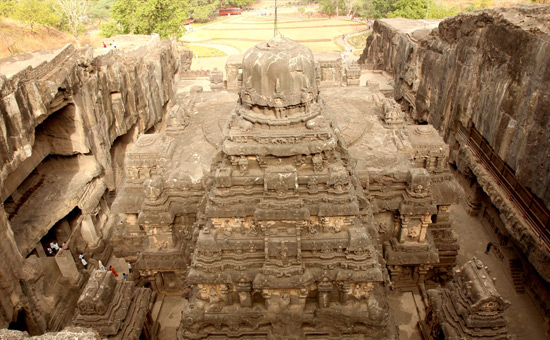 Kailasa Temple, Ellora.
Kailasa Temple, Ellora.
The Ellora Caves, a fusion of Buddhist,
Hindu, and Jain art, form an awe-inspiring gallery of rock-cut temples,
monasteries, and shrines. The intricately carved Kailasa Temple, a monumental
masterpiece, showcases the dedication and craftsmanship of its creators.
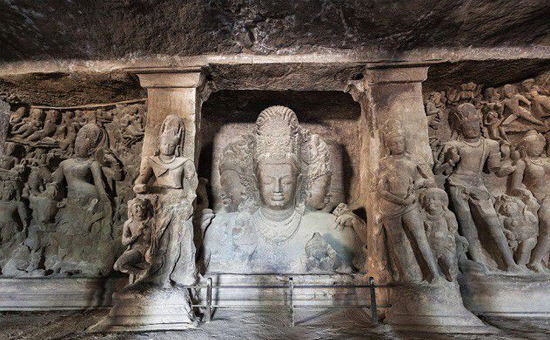
A short ferry ride from Mumbai, the Elephanta Caves stand as a testament to Shiva worship. The rock-cut sculptures depict various aspects of Shiva’s manifestations and mythological tales, revealing the deep interplay between spirituality and art.
These cave complexes offer a unique journey through time, a glimpse into the lives of ancient artisans and the communities that nurtured them. They illuminate the interwoven threads of art, culture, and religion that have shaped Maharashtra’s identity and continue to inspire visitors from around the world.
6 Gujarat
Gujarat, a land of vibrant culture and historical significance, hosts a collection of UNESCO recognized gems that celebrate its architectural diversity and cultural heritage. From the exquisite step-well of Rani ki Vav to the evocative Champaner-Pavagadh Archaeological Park, these sites weave a tapestry of Gujarat’s historical narrative.
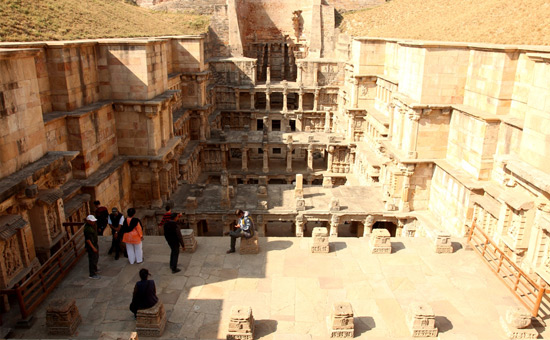
Rani ki Vav, a marvel of stepwell
architecture, showcases intricate sculptures and ornate carvings that depict
stories from mythology and everyday life. This subterranean water storage
system is not only a testament to hydraulic engineering but also a canvas for
artistic expression.
The Champaner-Pavagadh
Archaeological Park is a treasure trove of historical monuments spanning diverse architectural styles. The Jami Masjid’s blend of Hindu and Islamic elements, the Kevada Mosque’s delicate carvings, and the imposing Pavagadh Hill’s fortress are a testament to Gujarat’s syncretic heritage.
Vadnagar, (on UNESCO Tentative List) the birthplace of Prime Minister Modi, is a site of historical and cultural significance. Its Toran, a majestic ceremonial arch, and the Sharmishtha Lake reflect the region’s architectural and spiritual legacies.
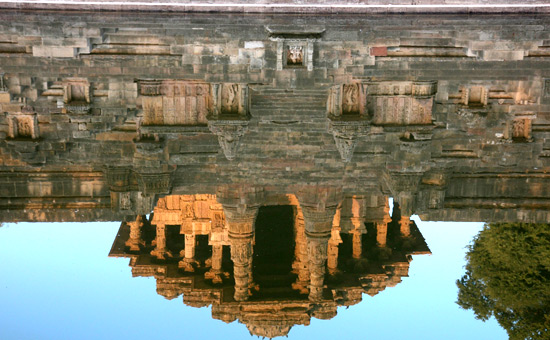
The Sun Temple in
Modhera and its adjoining monuments transport visitors to a time of devotion and artistic brilliance. The intricately carved temple and the stepped tank are architectural masterpieces that celebrate the sun god’s magnificence.
These UNESCO recognized sites in Gujarat encapsulate the state’s vibrant history, cultural exchange, and artistic excellence. They serve as a reminder of the region’s rich past and its enduring commitment to preserving its heritage for generations to come.
7 Rajasthan
Rajasthan, often referred to as the “Land of Kings,” stands as a repository of UNESCO recognized treasures that showcase its architectural brilliance and cultural heritage. From the Hill Forts of Rajasthan to the intricate Rows of Sandstone Haveli, these sites narrate the stories of Rajasthan’s past with eloquence.
 Kumbalgarh Fort.
Kumbalgarh Fort.
The Hill Forts of Rajasthan, including Chittorgarh, Kumbhalgarh, Ranthambore, and others, are emblematic of the state’s valor and strategic prowess. These forts, perched atop rugged hills, offer panoramic views and tell tales of royal dynasties, battles, and cultural evolution.
The Rows of
Sandstone Haveli in the Shekhawati region are a visual spectacle of opulent architecture. These elaborately adorned mansions boast frescoes, intricate carvings, and a unique blend of Indian and European influences, showcasing the prosperity and artistic inclination of Rajasthan’s merchant class.
The Jantar Mantar in Jaipur, an astronomical observatory, is a testament to the scientific knowledge and architectural genius of Maharaja Jai Singh II. Its precision instruments track celestial movements, reflecting Rajasthan’s intellectual contributions.
Rajput
Architecture,
seen in grand palaces like the City Palace in Udaipur and the Amber Fort in
Jaipur, exudes regal elegance and artistic finesse. These structures showcase
intricate carvings, sprawling courtyards, and the fusion of Rajput and Mughal
styles.
These UNESCO recognized sites in Rajasthan unveil the layers of its history, from valiant forts to ornate havelis and scientific marvels. They stand as guardians of Rajasthan’s past, inviting travelers to explore its cultural richness and architectural grandeur.
8 West Bengal
West Bengal’s architectural heritage is graced by the UNESCO recognized **Terracotta Temples**, a collection of intricately adorned structures that stand as a testament to the region’s artistic brilliance and cultural diversity. It is on UNESCO Tentative List.
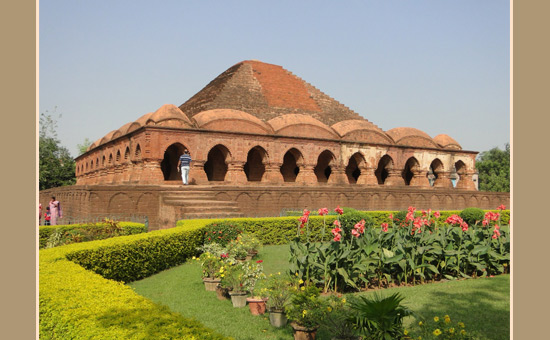
Rasmancha
Temple in
Bishnupur, adorned with terracotta carvings depicting episodes from the Hindu
epics, reflects the grandeur of the Malla dynasty.
The Jor-Bangla Temple, also in Bishnupur, boasts exquisite terracotta
panels that narrate stories from the Ramayana and Mahabharata.
Pancharatna
Temple, known for its five spires, in Bishnupur’s Lalgarh is adorned with intricate terracotta scenes from Krishna’s life.
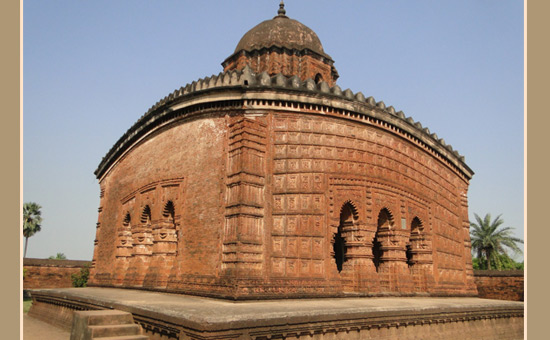
The Madan
Mohan Temple stands
as an architectural gem with its terracotta embellishments.
In the town of Hooghly, the Gauranga Temple depicts stories of Lord Krishna’s life through terracotta panels. The Chandannagar Museum and Sri Nandadulal Temple houses terracotta artworks that offers a glimpse
into colonial and religious history.
The Radha-Govindji
Temple in Antpur boasts terracotta art that captures Krishna’s divine playfulness. The Shyam Rai Temple in Bishnupur, dedicated to Radha and Krishna, is adorned with intricate terracotta panels that narrate Krishna’s life story.
These temples, with their terracotta adornments, serve as a gallery of West Bengal’s cultural heritage. They encapsulate stories, myths, and historical events, inviting visitors to appreciate the region’s artistic legacy and the creative expressions of its people.
9 Andhra Pradesh and Telangana
Andhra Pradesh and Telangana, two states steeped in history and artistry, are home to UNESCO recognized treasures that celebrate the region’s architectural and sculptural excellence. Lepakshi Temple is on UNESCO Tentative List.
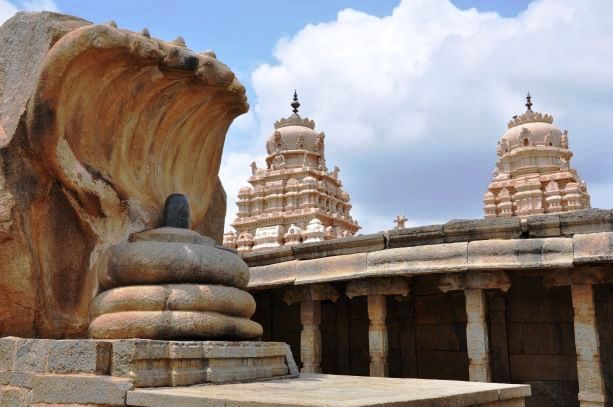 Nagalinga,
Lepakshi Mandir.
Nagalinga,
Lepakshi Mandir.
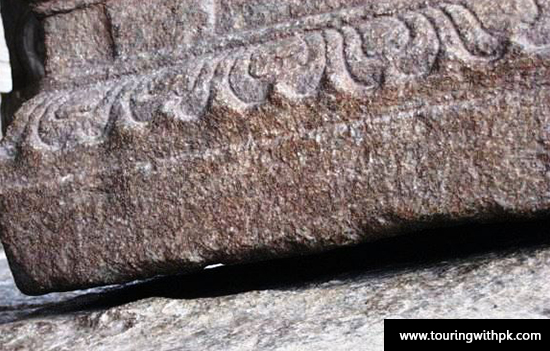 Hanging Pillar.
Hanging Pillar.
The Sri Veerabhadra Temple in
Lepakshi, Andhra Pradesh, is a marvel of Vijayanagara architecture. Adorned
with intricate carvings and vibrant frescoes, the temple narrates tales from
Hindu mythology. The colossal Monolithic
Bull (Nandi), a masterpiece of stone sculpture, stands guard at the temple entrance, a testament to the artisans’ skill.
Lepakshi’s artistic legacy continues with The Vijayanagara Sculpture and Painting Art Tradition that flourished during the Vijayanagara Empire. The exquisite carvings, murals, and sculptures found across the region reflect the intricate detailing and artistic sensibilities of the era.
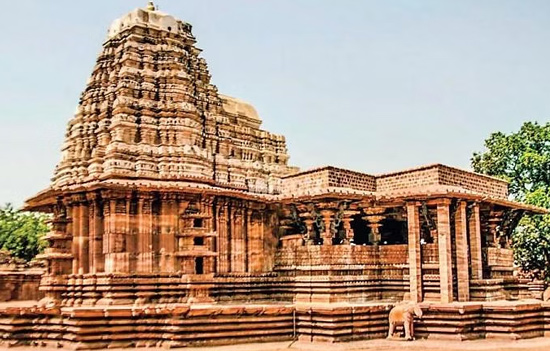
In Telangana, the Ramappa Temple,
also known as the Ramalingeswara Temple, stands as a masterpiece of Kakatiya
architecture. Its intricate carvings and remarkable engineering prowess reflect
the artistic and technological advancements of the time.
These UNESCO recognized sites in Andhra
Pradesh and Telangana serve as a bridge to their illustrious pasts. They are
not only architectural wonders but also repositories of artistic and cultural
expression, inviting visitors to delve into the intricate stories and creative
achievements of the region.
10 Odisha
Odisha, a land of ancient temples and
architectural marvels, boasts UNESCO recognized historical treasures that
reflect its rich cultural heritage and artistic legacy.
Ekamra Kshetra-The Temple City, Bhubaneswar,(on UNESCO Tentative List) encompasses a vast array of temples, each with its unique architectural style and spiritual significance. The Lingaraj Temple, dedicated to Lord Shiva, is a masterpiece of Kalinga architecture, adorned with intricate carvings that depict stories from Hindu mythology. The Mukteswar Temple, known for its exquisite torana (arched gateway), is a gem of Orissan architecture. The Parashurameshvara Temple, with its stunning sculptures, adds to the city’s architectural diversity.
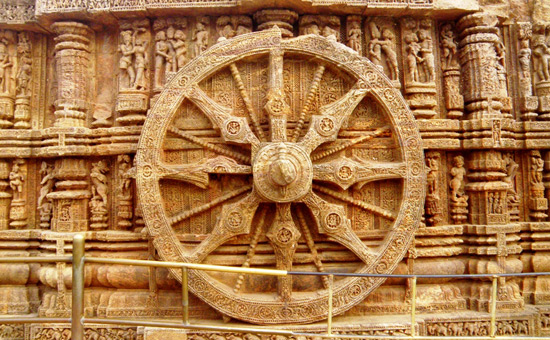 Wheel, Sun Temple.
Wheel, Sun Temple.
The Konark Sun
Temple, a crowning jewel of Odisha, is a UNESCO World Heritage Site that exemplifies the region’s architectural finesse. Its intricate carvings depict celestial beings, animals, and daily life scenes, intricately capturing the nuances of ancient Indian art and culture.
These UNESCO recognized sites in Odisha are more than just architectural wonders; they are living testaments to the region’s spiritual devotion, artistic brilliance, and historical legacy. They inspire awe, curiosity, and a deep appreciation for the craftsmanship and creativity that have shaped Odisha’s cultural identity over the centuries.
In conclusion, India’s UNESCO recognized historical architectures are not just stone and mortar; they are living witnesses to the nation’s rich and diverse past.
Each of the Indian states highlighted above
offer a unique tapestry of cultural, artistic, and architectural achievements
that transcend time.
From the intricately carved temples of Karnataka to the rock-cut wonders of Maharashtra, from the spiritual sanctuaries of Bihar to the syncretic marvels of Gujarat, from the regal forts of Rajasthan to the terracotta temples of West Bengal, and from the artistic treasures of Andhra Pradesh and Telangana to the ancient temples of Odisha, these UNESCO sites narrate India’s story through architecture, sculpture, and craftsmanship.
These historical treasures serve as bridges between the past and the present, inviting travelers and enthusiasts to explore the layers of history etched into their stones. They symbolize not only the artistic genius of their creators but also the enduring spirit of India’s cultural diversity and heritage.
As guardians of India’s past, these UNESCO recognized sites beckon us to contemplate the wisdom, creativity, and devotion of those who came before us. They stand as a testament to the resilience of history and the power of architecture to transcend generations, inspire awe, and deepen our understanding of the world’s most ancient and enduring civilizations. In their presence, we can connect with the soul of India and marvel at the beauty and complexity of human expression throughout the ages
Author Debojyoti Dey Mazumder is one of the directors of Promise India Tourism Pvt Ltd, that has been in the tours and travel business since 2010. All pictures by esamskriti unless stated.
First published Here
To
see albums of above World Heritage sites
1. Bodh Gaya Temple, one of three albums
2. Nalanda University
3. Rani-ki-Vav Patan, Gujarat
4. Surya Mandir, Modhera
5. Belur Temple, one of 2 albums
6. Pattadakhal Temples
7. Halebidu Temples, 1 of 3 albums
8. Aihole Temples, 1 of 2 albums
9. Somnathpura Temple near Mysore
10. Badami Caves
11. Hampi, Karnataka
12. Kandariya Mahadev Temple, Khajurao, Madhya
Pradesh
13. Sanchi Stupa, near Bhopal
14. Bimbetka Rock Shelter
15. Orchha, near Jhansi
16. Mandu, 1 of 2 albums
17. Ajanta Caves, 1 of 4 ablums
18. Kailasa Temple Ellora, 1 of 4 albums
19. Elephanta Caves
20. Chittorgarh Fort
21. Amber-Jaigarh Forts
22. Kumbalgarh Fort
23. Mehrangarh Fort
24. Jaisalmer Fort
25. Havelis of Jaisalmer
26. Jantar Mantar, Jaipur
27. 5 Rathas of Mahabalipuram
28. Sea Shore Temple Mahabalipuram
29. Brihadesvara Temple, Thanjavur +
Gangaikondacholapuram Temple
30. Darasuram
Temple, Kumbakonam
31. Srirangam Temple, Trichy
32. Kailasanathar Temple, Kanchipuram
33. Perumal Temple, Kanchipuram
34. Veerbhadra Temple, Lepakshi
35. Temples of Bishnupur, West Bengal
36. Durga Puja, Kolkata
37. Sun Temple Konarak, 1 of 2 albums
38. Temples of Bhubaneshwar
39. Valley of Flowers, Uttarakhand
40. Kaziranga National Park
41. List of UNESCO Heritage sites India